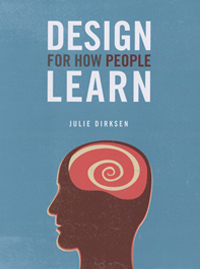I've long been an advocate of matching our learning interventions to how our brains really learn. While there's justifiable skepticism about some of the so-called brain science, work that systematically leverages research in cognitive learning is welcome.
 Now, Julie Dirksen, known for
her work on usability in eLearning, has written Design for How People Learn, a guide to better learning
design, and I have to say it's a really
good book! Julie used to work for Michael Allen (CEO of Allen Interactions and
author of Michael Allen's Guide to
eLearning), and with her own studies into cognition and learning, she
really gets the necessary underpinning.
Now, Julie Dirksen, known for
her work on usability in eLearning, has written Design for How People Learn, a guide to better learning
design, and I have to say it's a really
good book! Julie used to work for Michael Allen (CEO of Allen Interactions and
author of Michael Allen's Guide to
eLearning), and with her own studies into cognition and learning, she
really gets the necessary underpinning.
A lively, fun, valuable read
Don't be misled, however: this is not a stuffy academic book. In fact, reading this book is fun. There's a very liberal use of drawings, stock photos, and other ways to make the ideas she is presenting visually concrete – and the prose is pithy and humorous. In short, this is a fun read as well as a valuable one. Julie Dirksen doesn't take herself too seriously, yet she addresses the subject matter with appropriate passion and insight, yielding a welcome balance. I don't know if this a hallmark of the imprint but credit goes to her publisher for supporting such a lively style.
The book focuses on a very practical approach to designing learning, drawing upon what we know about how our brain works, and then applying it. And, most importantly, the book goes beyond the traditional ID paradigm about intro, concept, example, etc., and includes the emotional (motivational) side of the equation. Dirksen also (thankfully) points out the role of performance support, helping designers recognize that not every solution is a course.
A nice touch is the use of a recurring metaphor of an elephant and the rider, emphasizing how we as learners have pressures to accommodate short-term goals as well as a focus on long-term goals – and the tension between them. This recurrent theme helps illustrate how our best intentions go awry if we don't focus on the competing desires of, and demands on, the learner. She uses this structure to help design solutions that can leverage both requirements to optimal advantage with minimal interference.
Focuses on the issues
Julie starts by addressing the performance gap, does a good job of emphasizing knowing your learners, and focuses on what the goal should be. Even the chapter titles lay out the issues at hand:
- Where do we start?
- Who are your learners?
- What’s the goal?
- How do we remember?
- How do you get their attention?
- Design for knowledge
- Design for skills
- Design for motivation
- Design for environment
- Conclusion
Lots of concrete examples illustrate the principles. Drawing on both Julie's experience and hypothetical examples, the book brings to life the ideas that she talks about. You can see quite viscerally how the concepts play out in context. She also draws upon a wide variety of influences for models to think about, which I strongly support, yet she grounds the models in metaphors to make them accessible.
She provides nice references, too, with a list of readings at the end of every chapter that both grounds the discussion and provides further directions. And Julie’s not afraid to take on some common myths – for instance debunking learning styles. On the other hand, she does refer to Bloom’s Taxonomy, which is familiar, though arguably flawed.
Quibbles
The book doesn't quite accomplish everything I wish designers would draw upon; for example there's no real discussion of when to abandon formal solutions and look to the community for solutions. There are minor hints and tips that could've been included (I'll be sending her a list for the 2nd edition J. Yet these are minor quibbles.
Recommendation: Buy this book!
Frankly, this is the best book on learning design I've seen for the beginning designer, particularly those who haven't had the necessary foundations and experience. This is the quick start anyone designing learning should use to get to success the fastest. I reckon if everyone designing learning had this book under their belt, we'd have a lot less garbage eLearning. Buy it, read it, pass it on, spread the word. Between reading this, and Collins and Brown's Cognitive Apprenticeship, you've got a good head start on a “life experience” Master's degree in instructional design.
Bibliographic information
Dirksen, Julie. (2012) Design
for How People Learn. Berkeley: New Riders. 260 pages.
ISBN
978-0-321-76843-4.
Publisher’s List price: US$39.99
Available online at http://www.peachpit.com/CreativeEdge
Amazon: US$22.89 (paperback); US$13.68 (Kindle)
Barnes & Noble: US$22.89 (paperback); US$20.79 (Nook)



